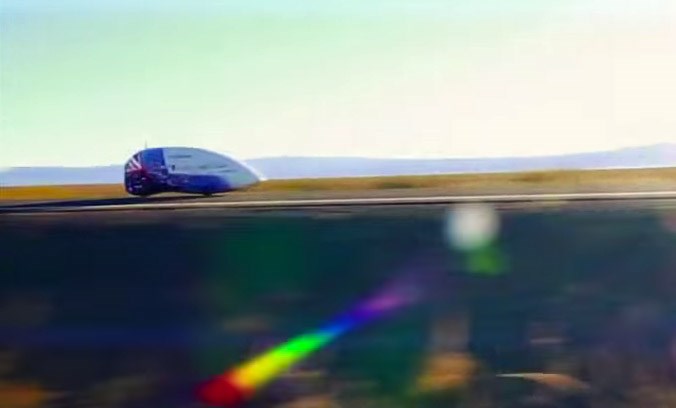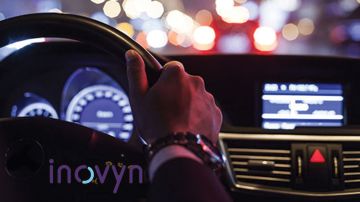IT was a chance to help students on the University of Liverpool Velocipede Team to build the fastest bicycle in the world – and INEOS wasn’t about to let an opportunity like that slip away.
As the engineering students from the University of Liverpool in the UK worked quietly on their speed bike ARION1, INEOS was ready to fly them and their incredible vehicle, to America for the World Human Powered Speed Challenge.
“I knew it was something that INEOS would be interested in supporting because it combined sport, engineering, entrepreneurial spirit and a small team with limited experience prepared to take on the world,” said Iain Hogan, CEO of INEOS O&P South. “The students had enough sponsorship to get the bike designed and built but initially, they didn’t want our help because they weren’t sure they had a vehicle that could take on the record.”
But the more tests done at Bruntingthorpe Proving Ground, the more the 16 students, including team leader, Iain’s son Ben, realised it might just be humanly possible to break the world record of 83.13 mph, and so to INEOS they turned.
What the students desperately needed was a company with the knowledge and experience to transport the bicycle and the whole team to the middle of the Nevada desert and back again.
“Without the support of INEOS the team would not have made it to the competition,” said Ben. “INEOS took charge of arranging the logistics of getting our enormous flight case, which looks more like a small caravan, all the way from our home in Liverpool to the middle of the desert – and back again safely. It was vital our flight case, which contained the bicycle and all our tools, arrived on time and intact. We really needed a company that knew what they were doing.”

David Thompson, Chief Operating Officer of INEOS Trading and Shipping, was the man called upon to help the team. His team imports and exports materials to and from the USA every day of the week.
“It could have been a logistical nightmare,” he said. “But we knew how to handle US and European customs to make sure the bike, and all the spares and maintenance equipment, could enter the US without delay, and then reverse the process back into Europe.”
In tests, the ARION 1 land speed vehicle, which is encased in a carbon fibre shell to help it slice through the air, had topped speeds of more than 50mph.
“Carbon fibre composite was the ideal material for fabricating the vehicle because you can mould it to almost any shape that you want,” said Ben. “So we did.”
The rider sees where they are going using a tiny video camera mounted of top of the capsule, which makes piloting it particularly difficult.
“You’d have to imagine driving a motorcycle looking through your mobile phone,” said Ben. “And with nothing but that to show them the outside world and no ventilation, it can be claustrophobic. Thankfully the rider is only in there for about seven minutes so it is bearable.”
But despite the £150,000 cost of the bicycle, it’s not a comfortable ride.
“Inside it is extremely noisy and sounds a bit like a jet engine,” said Ben. “All the sounds from the chain and the wheels reverberate inside the shell. A lot of the time we had problems hearing our rider over the radio.”
The bike had six gears, similar to a normal bike, only much larger, “The front chain ring had 104 teeth” said Ben.
But the ARION1 rider changed gear only when the bike told him to.
The team had worked on perfecting their bicycle for almost two years.
“It became an obsession,” said Ben. “The team didn’t bother taking a summer break this year. We stayed at university and worked seven days a week to get it finished.”
The world human-powered vehicle challenge takes place every year on Route 305 – a five-mile stretch of road in the middle of the Nevada desert.
Teams from all over the world enter vehicles they have designed and built themselves.
Speeding up in an attempt to go the fastest is only one thing, though.
Slowing down is quite another.
“It’s not very easy to slow down after reaching speeds of 75mph,” said Ben. “At the end of the course is a one-mile stretch of track left to stop the bike. And as the rider is unable to stay upright once the bike stops, the team has to catch the bike while it is still moving. That, in itself, takes some skill.”
Although the British team did not break the world speed record, their two riders smashed the 13-year old UK land speed record three times.
Ken Buckley was first to do it. He clocked 69.7mph, then fellow rider David Collins, a PhD student, notched up 70.6mph, only for Ken to hit 75.03mph – and, in the process, generate enough energy to boil a kettle.
“Breaking the British record by nearly 8mph is no mean feat,” said Ben.
What was particularly impressive about Ken’s record-breaking run is that he notched up 75mph just 15 hours after a nasty crash at 55mph when a sudden gust of wind and an unexpected bump in the road caused him to lose control of the bike.

“Wind and weather are two big hazards,” said Ben. “With such a long course the wind can blow in totally different directions and that can catch the rider by surprise. If Ken had said he wanted to stop then, we would have understood it but he was determined to try again.”
And determination is one of the reasons he was selected from the many hopefuls.
The riders also needed an excellent sense of balance while lying down.
“Essentially you have to learn to ride a bike again because it is so different,” said Robert McKenzie, who has now taken over the project following Ben’s graduation.
And the riders needed courage.
“It is dark and claustrophobic in the bike and furthermore you are taped in and expected to pedal as fast as you can,” he said.
Thankfully Ken was unhurt in the crash but the exterior shell and steering were damaged which meant the UK team had to work through the night to make it possible for their riders to attempt breaking records again.
Although the British team were unable to match the Canadian team, whose co-designer and rider Todd Reichert set a new world record of 85.71 mph, they have got their sights set on it next year.
ARION 2 will be smaller, lighter and more stable.
“We have got the British record at our first ever attempt and if one day we get to bring the world record back to Britain that would be incredible,” said Ken.
And INEOS will be there again to support that second attempt.


















